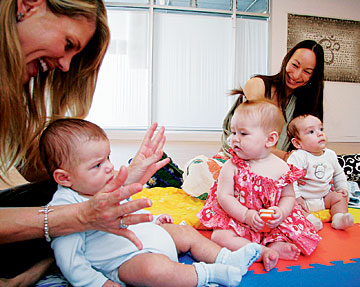
CRAIG T. KOJIMA / CKOJIMA@STARBULLETIN.COM
Debbi Krekel, left, holds son Kanoa as she teaches him baby sign language. Opening up her hands and waving them means "finished." Baby Kirra Simpson, center, takes mental notes as Wanee Gomez, right, looks on, holding Noe. Below, Sara Simpson teaches daughter Kirra a few words.
|
|
Language of love
Advocates say that teaching babies sign language also boosts their verbal skills later
JUST because babies are unable to speak doesn't mean they have nothing to say. They are always trying to express their needs, and unfortunately, the most accessible form of language is to babble incoherently or to wail, loudly.
BENEFITS OF BABY SIGNS
» Reduces tears, tantrums and frustration
» Allows babies to share their worlds
» Increases respect for babies
» Strengthens the parent-infant bond
» Boosts self-esteem and self-confidence
» Makes learning to talk easier
» Stimulates intellectual development
Source: www.babysigns.com
|
Wanee Gomez wanted to learn a more efficient way to communicate with her 4-month-old son, Noe. "I know he's trying to tell me something. He makes lots of noises, and I don't know what he wants," she said. So, they started attending a Baby Signs class together.
Babies who learn sign language have fewer frustrations, according to Sara Simmons, a sign language instructor for the Baby Signs class at Purple Yoga Hawaii. Simmons has taught sign language for more than 10 years and runs the Kapiolani Deaf Center.
"Instead of playing the pointing or guessing game, you know exactly what they want," she said.
The practice also enhances infants' vocabulary and language skills, giving them a boost in future communication skills.
The class introduces moms and infants to basic signs pertaining to feeding, bath, feelings, family and animals. Songs and stories are also incorporated into each session.
"Using sign language with babies often gives them a jump-start on language," said Simmons. "They benefit from early exposure to sign language but may not begin signing on their own for around eight or 10 months."
Making a visual connection helps, for example, using the sign for milk consistently when nursing or using bottles.
Debbie Krekel saw the advantage of teaching youngsters sign language firsthand.
"My nephew learned sign language, and now he is an excellent reader," she said. Even though there is no concrete way of establishing a correlation, Krekel believes the early start on communication made a difference. She is currently attending a Baby Signs class with her 5-month-old son, Kanoa.
Interaction with other babies is another reason for attending classes. "It is good for them to be stimulated at a young age. The babies are intrigued by one another."
SOME PEOPLE have misconceptions about teaching youngsters sign language.
"People are worried that they won't learn to speak. But, in fact, they are learning two languages," said Amanda Kaahanui, another baby sign language instructor, who follows Joseph Garcia's teaching of "Sign2Me."
"Don't stop speaking to your child. Speak and sign at the same time. It encourages them. ... You are giving them language," Kaahanui added.
Babies generally respond at around 7 to 8 months, she explained. "Start as soon as possible, and make it a part of your routine. Make it fun."
One way to make things enjoyable is to learn signs to tell a story. Kaahanui suggested using Peggy Rathmann's "Good Night Gorilla" because the book has few words. Look at the pictures and learn the signs, she said.
The fundamental difference between the classes is that Baby Signs allows made-up signs between the mother and child. Sign2Me specifically uses American Sign Language.
"It is like learning standard English compared to pidgin English," she said. Both work, but if a person plans to continue with sign language, it is better to learn the correct signs, she explained. Many people discontinue using the signs once a baby becomes verbal. In that case, made-up signs work just fine.
Kaahanui's son is hard of hearing and has a tracheotomy tube that prevents him from speaking.
"Sign language is the best way to communicate with him," she said. Kaahanui had planned to teach her son sign language even before she learned of his hearing and verbal challenges.
The classes are primarily for hearing babies. "If an 18-month-old says, 'I want milk or juice' and you respond, they feel like you are listening," she said.
They are definitely aware of their surroundings. And, once they start signing, it is apparent, added Kaahanui. "They will notice a bird in the tree or a plane in the sky."
"Preschoolers love to do sign language," she added. "They are so active and like to pretend-play."
There are other advantages for the child who knows how to sign. If kids can learn the sign for bathroom, they won't have to scream out in public places. Some youngsters might even feel as if they are learning a "secret language."
CLASSES
The next Baby Signs class at Purple Yoga will be held in March from 10:30 to 11:30 a.m. Fridays. The cost is $60. Amanda Kaahanui can be reached at 384-8936. Other classes are offered by the following instructors:
Florence Dixon: Classes, workshops, presentations, music and signing sessions, play groups offered on all islands. Call 381-0273.
Liz Stone: Oahu, 230-9164 or e-mail alohababysigns@hawaii.rr.com
Ashley O'Neil: Oahu, e-mail babysignswithashley@yahoo.com
Cristina Clemons: Maui, 808-268-2907
Cheryl Yoshida: Maui, 808-357-5740 or e-mail cherylbabysigns@hawaii.rr.com
For more information: Visit www.babysigns.com or www.sign2me.com.
|

